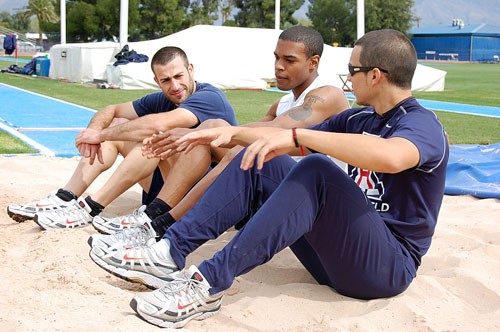It’s been said that for every great athlete who has made it to the top, there is an equally great athlete who has not. Nothing is truer in the case of track and field.
Arguably among the best individual athletes of all teams, UA track and field athletes will be the first to tell you the mental side of the game plays just as big a role as being physically fit and having good form and good coaching.
“”The mental aspect of (track and field) is as important or more important than the physical part,”” said UA thrower Megan Howard. “”(Unlike other sports) you have no one to blame but yourself if you do poorly.””
The focus on the individual athlete puts more emphasis on pushing themselves to be better than their competitors because there is no one else to put them over the hump.
“”(The coaches) can’t go out there and run the race for them,”” said UA head coach Fred Harvey. “”Our job is just to make sure they’re as focused as they can be when they do go out there and compete.””
One issue that affects athletes is the fact that in track and field most of the focus comes on athletes doing just enough to win. There are very few dominating performances because the first-place finishers only push themselves to finish first.
“”If I know there is going to be good competition I will get a lot more competitive than I would in a race where the competition isn’t as good,”” said distance runner Dylan Fitzpatrick.
This sentiment also puts a lot of pressure on the coaches to get their athletes into a race with better competition, because the better times run or distances thrown will come against the better athletes. While coming down to the level of the next-best opponent may help reduce injuries or fatigue, it doesn’t help the athletes when a NCAA qualification is decided by earning the best mark possible.
At the Division I level, many of the athletes are as much as an astounding physical specimen with perfect form as the person they are competing against. In a sport where victory is decided by fractions of a second or less than an inch, athletes are constantly looking for a way to push themselves to that next level that’s just better than the next best person.
Several UA athletes have their own methods and good luck charms to keep their focus and help them shed off that tenth of a second or jump that inch higher.
“”It’s really the stupid things we do before a meet that can make the biggest difference,”” said high jumper Liz Patterson, who likes to have dance parties in her hotel room before heading out to the venue.
Distance runner Marissa Urban says she has to take a shower right before a race because it “”feels like that day is washed away and I can start fresh for the race.”” She also wears the same sports bra for every meet.
Thrower Andy Keller likes to flex in the mirror before he goes out to make himself feel stronger and runner Christina Rogers writes the goal she hopes to achieve on the bottom of her foot.
Long jumper Daniel Marshall, however, may have the most elaborate routine of all. The night before a meet Marshall shaves his legs. After that he packs his competition uniform in his bag in the exact order he will put it on the next day. Finally, he wears a red and blue sock and said he always takes off with the foot the red sock is on.
The long jumpers also started a new routine before the Feb. 29-March 1 Mountain Pacific Sports Federation Championships in Seattle – they shaved the heads of the two newest members.
“”Daniel and Jordan (Powell) have always had shaved heads,”” said Luis Rivera, who joined the team this year. “”So they told me and Stefanos (Michael) that if we wanted to jump like them we had to look like them.””









